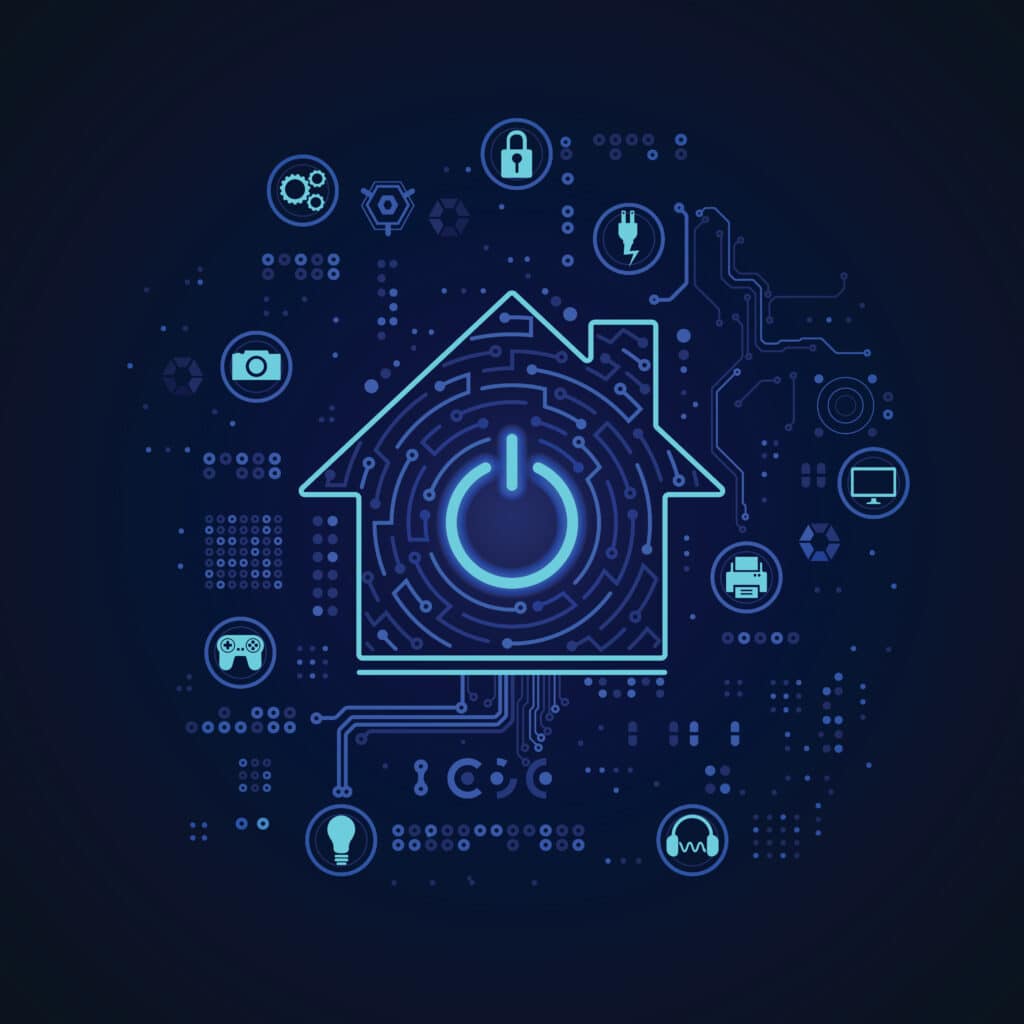Many homeowners with smart home technology ask, “What does a surge protector do?”. Since smart homes have become increasingly popular over the past few years, so does the risk of power surges and voltage spikes.
These electrical disturbances from storms and power management issues can cause irreparable damage to expensive smart home devices, equipment, and appliances — leaving homeowners with high repair or replacement bills.
This is where a surge protector comes in. A surge protector with power management helps safeguard your home’s power and smart home technology against power surges. Below we’ll answer, “What does a surge protector do?”, and how it can protect your smart home investments from electrical damage with automated power management.
What Does a Surge Protector Do for Smart Homes? A Guide to Power Surges & Smart Power Management
So, what is a surge protector used for? And exactly, what does a surge protector do? The purpose of a surge protector is to protect your home from power surges that can disrupt, damage, and destroy your electronics. Power surges, or transients, are overvoltage spikes or electrical disturbances.
A surge protector is designed to limit these transients, divert them, or both. Surge protectors help diverge high surge currents from reaching your devices to prevent their power supply from frying.
There are three types of effects of power surges on electronic equipment:
- Disruptive effects– flickering lights, system lock-ups, malfunctions, lost files, etc.
- Dissipative effects– long-term degradation, shortened lifespans, shutdowns, etc.
- Destructive effects– highest transient levels that cause equipment failure
If you notice any of these effects in your home, these are signs that you should invest in a surge protector.
Home Power Surges: Internal vs. External Causes
Myth: Lightning or severe weather are the leading causes of power surges in homes.
Fact: Most causes of power surges in homes are internal.
Power surge transients can reach up to thousands of volts in amplitudes and are caused by internal and external factors. According to the National Electric Manufacturer’s Association (NEMA), 60-80% of electrical surges occur internally, including in homes and businesses.
Some internal causes of power surges in homes are:
- Many high-energy consumption devices and appliances connected (non-energy efficient technologies)
- Heavy use of power strips with no surge protection (not all power strips are surge protectors)
- Large appliances powering on and off, like refrigerators and air conditioners
Some external causes of power surges in homes are:
- Lightning and severe weather conditions
- Power lines and transformers damage
- Power grid and capacitator bank switching
It’s also important to note that no surge protection system can handle a direct lightning strike. If you suspect a surge coming, disconnect all sensitive electronics to prevent power surge damage.

If you’re unsure if your home’s electronics are contributing to internal electrical overloads or power management issues, contact AIS for help. We can recommend energy-efficient home automation technologies to prevent power surges caused by high-energy consumption devices.
Types of Home Surge Protection: Whole-Home, Uninterrupted Power Supply (UPS) Units, & Surge Protection Devices (SPDs)
There are three main types of home surge protection systems — whole-home surge protection, uninterrupted power supply (UPS) units, and surge protection devices (SPDs).
Whole home surge protection is straightforward — it’s a surge protection system that helps protects your entire home from major power surges. It protects your entire electrical distribution network, devices, and appliances. However, smaller transients may slip through since not all power surges are equal. This is why investing in multiple forms of home surge protection, like UPS units and SPDs, is vital.
Uninterrupted power supply (UPS) units are designed to be a battery power backup during power outages caused by surges. They’re not intended to be long-lasting but do provide basic home surge protection.
There are three types of UPS systems:
- UPS Standby– standard battery backup during outages and basic power surge protection,
- UPS Line Interactive– best for high and low voltage fluctuations for balanced voltage quality and battery backup
- UPS Online/Double Conversion– eliminates voltage fluctuations and other distortions common in grid power (designed for commercial-size equipment)
Lastly, surge protection devices (SPDs) are the most recognizable surge protection system because they’re designed for consumers. Some examples of SPDs include power strips and plug-in adapters, however, it only protects the devices it’s connected to.
| Whole Home Surge Protection | Uninterrupted Power Supply Unit (UPS) | Surge Protection Devices (SPDs) |
| Professional installation required | Professional installation or plug-and-go setup | Plug-and-go setup |
| Whole home premium protection | Whole home basic protection and battery power backup | Only protects connected devices |
| Longest lasting and most powerful power surge protection | Not designed to last for extended amounts of time during power outages | Requires more frequent replacement and after a major power surge |
| Highest costs | Varying costs | Lowest costs |
These surge protection systems are classified into category types based on location, installation, and coverage —Type 1, Type 2, and Type 3.
Below is a reference guide on Type 1, Type 2, and Type 3 surge protection:
- Type 1 (Service Entrance Surge Protection)– highest level of surge protection, installed inside the home’s main electrical breaker, meter-based, protects against large surges, small surges may pass through
- Type 2 (Whole Home Surge Protection)– long-lasting protection, installed inside the home’s main electrical panel, panel-based, protects against large and small surges depending on model
- Type 3 (Point-of-Use Surge Protection)– also known as receptacles, plug-and-play setup, SPDs like power strips and plug-in adapters, only protects devices connected to it
Although there are three main surge protection categories, some products offer features of multiple types. It’s best to have multiple layers of surge protection for homes, especially ones with expensive smart home technology for optimal coverage.
What does a surge protector do for smart homes?
Homeowners with home automation commonly ask, “Are surge protectors necessary for smart homes?” or “Do I need a surge protector for my smart home?”. We always recommend that homeowners invest in surge protection for their smart homes to prevent costly damages to their valuable assets. As the number of connected smart devices and appliances increases, so does the risk of electrical overloads and power surges if they’re not set up correctly.
Although one of the best smart home benefits regarding surge protection is that they’re designed to be energy-efficient (which lowers the risk of internal electrical overloads), nothing is immune to lightning or high-power transients. Smart home technology isn’t typically manufactured with surge protection, so homeowners should protect their investments by using surge protectors.
If you’re a homeowner wondering, “What does a surge protector do for smart homes?”, there are many ways it protects your smart home investments. Below we’ll break down four benefits of using surge protectors with power management in smart homes.
Smart Power Management Systems Better Prepare Homeowners for Power Surges
For the best possible results, homeowners should use a smart power management system in addition to their surge protection systems. A power management system helps homeowners monitor their smart homes for power surges and better prepare them to prevent electrical damage. By integrating power management with home automation, homeowners can easily monitor if their smart technologies are safe from surge damage and manage their power systems.
Power management systems can offer the following features for smart homes:
- Electrical system health monitoring– track if the power is balanced in your electric distribution system
- Capacity management– check for electrical overloads for better load balancing
- Equipment tracking– confirm if power quality issues are from power grids or your electrical distribution system
- Power event analysis– advanced power quality monitoring with analytics to identify and respond to the root causes of power surges
Power management systems can also be compatible with your current home automation system to manage everything in one place, depending on the model. Using SPDs and a power management system offers smart homes the best surge protection coverage, optimized power supply, and energy performance.
Adds Convenience to Access Smart Home Technology During Power Outages
One of the biggest benefits of smart home surge protectors is functionality during a power outage. Uninterrupted power supply (UPS) units have battery backup that protects smart devices from power surges and helps them run when the power goes out.
For example, your internet and smart home security system can still be accessed via a UPS unit during a power outage. Homeowners can enjoy the convenience of not having their WFH schedules disrupted, home security systems still monitoring, and access to other necessary smart home systems.
It’s important to note that UPS units aren’t designed to power smart homes for an extended time. If there are extended power outages, battery backup isn’t intended to be long-lasting, so having multiple layers of surge protection like whole-home systems and SPDs is crucial.
Prevents Costly Repairs from Power Surge Damage on Smart Home Technology
Did you know the average home has $15,000 worth of electronic equipment that power surges can damage? Home automation manufacturers generally don’t include power surge protection in their product’s warranty terms. Most manufacturer labels state to plug their smart devices into a surge-protected outlet, power strip, or other surge protector device (SPD).
So, if your smart devices aren’t surge-protected and break due to a power surge, they most likely won’t be covered under warranty — leading to high repair and replacement costs.
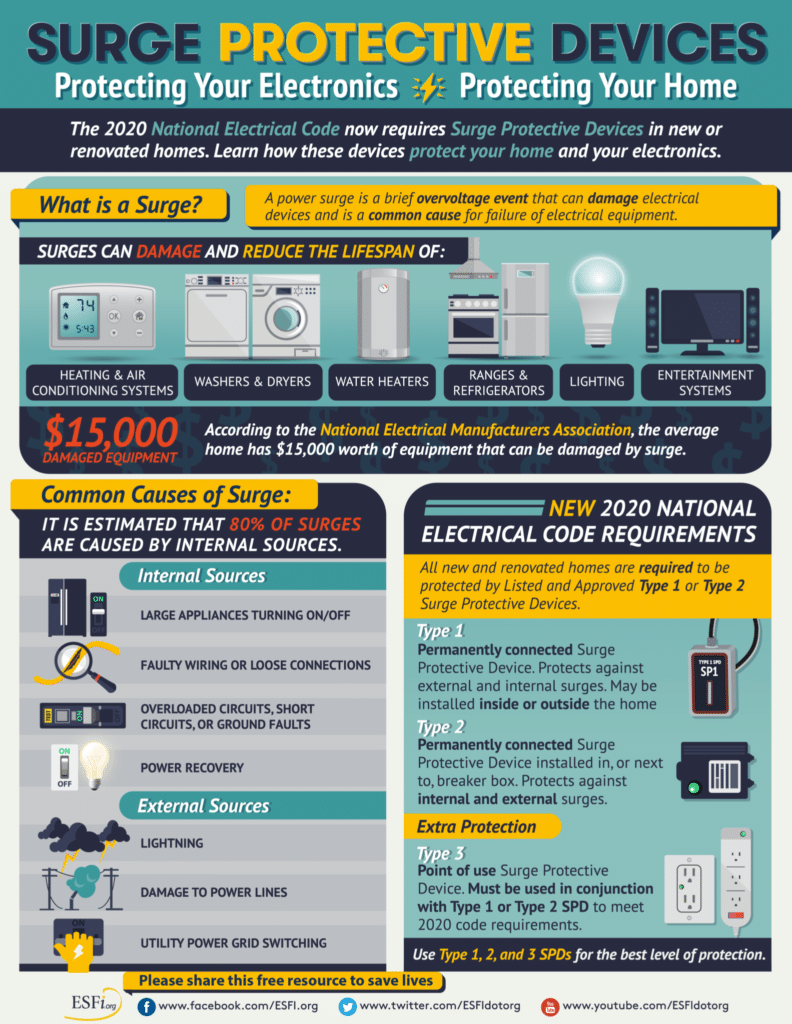
For homeowners with smart homes wondering, “Do I need a surge protector for my TV?”, the answer is yes! Smart TVs, screens, and monitors typically break first when exposed to a power surge. Whether it’s a power grid disruption or a home’s routine power meter replacement, these can cause power surges that break expensive smart home technology and media.
New Home Builds and Renovations Now Require Surge Protection Devices (SPDs)
Since 2020, the National Fire Protection Association (NFPA) has stated in the National Electrical Code (NEC) that new construction or renovated homes now require surge protective devices (SPDs).
The current NEC requirements for SPDs include the following:
- All new and renovated homes are required to have listed and approved Type 1 and Type 2 SPDs
- Type 1 SPDs may be installed inside or outside the home
- Type 2 SPDs must be permanently installed in or next to the breaker box
- Type 3 SPDs may be used, but must be in conjunction with Type 1 and Type 2 SPD requirements
If you’re building a custom smart home or renovating, the best time to integrate your home automation with surge protection is during the design phase. Homeowners and builders often make smart home mistakes by integrating home automation with their power management system after buildout.
We always recommend that homeowners plan smart home ideas for new construction as early as possible because they’ll need to hire integrators to work with their builders or designers. High-voltage electricians aren’t trained in low-voltage home automation integration – so including integrators in their construction processes is crucial to seamless collaboration.
Integrators and contractors work together to ensure you get the most out of your smart home build or renovation. Integrators communicate with electricians to ensure they know the electrical requirements for the homeowner’s smart devices and systems. This helps ensure the electricians run the correct outlet types and power in the locations of your home that these smart technologies require.
Every smart home is different and will require unique power management and surge protection solutions. For the best possible results, ensure your designers or builders work with custom system integrators to connect your SPDs with your home automation system during the design stage.
Smart Home Surge Protection & Devices AIS Recommends
Now that you know the answer to, “What does a surge protector do?”, the next step is to protect your most valuable smart home assets. Below we’ll break down the types of smart home surge protection homeowners should invest in with product recommendations from the AIS pros.
Whole Home Surge Protection with Wired Power Management Integration
The first type of smart home surge protection we recommend is whole-home surge protection. According to the National Electrical Manufacturers Association (NEMA), single-surge protective strips aren’t enough to protect a home from power surges. Most homeowners understand that surge protectors are necessary. But they typically don’t buy until after surge damage or only get plug-in surge protection devices (SPDs).
Whole home surge protection is foundational to complete coverage of all your smart home devices and equipment. SPDs only protect the devices that are connected to them. For example, smart power strips with surge protection will only connect devices plugged into them, not your entire smart home. Smart homes may have wired home automation and smart security systems that don’t plug into smart power strips. If homeowners only invest in SPDs, this leaves other parts of their smart home vulnerable to power surge damage risks.
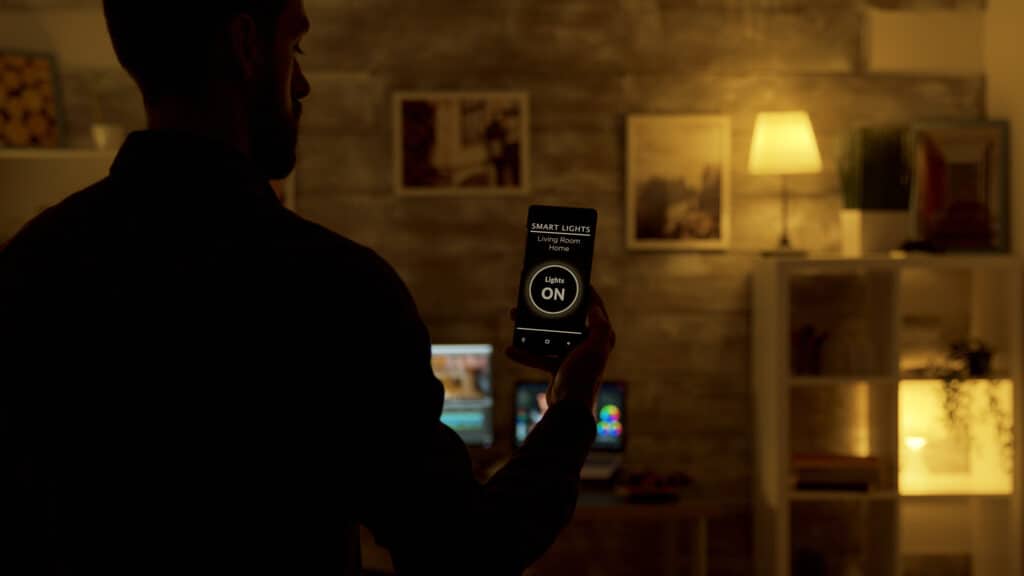
We always recommend using home automation installers certified by the Home Technology Association (HTA) to integrate a power management system with your smart home. Faulty wiring from electricians or contractors not specialized in wired home integration can cause electrical fires and power surges. Wired integration offers the strongest networking and connection possible for smart home power management systems over wireless.
At AIS, we’re proud to be HTA-certified to provide homeowners with the highest standards in home automation. We help guide homeowners through the power management integration process for their smart homes to get the best surge protection results.
Whole-Home Surge Protection Brand Recommendation: Siemens
For whole-home surge protection, Siemens is one of the brands recommended by the NEMA (National Electrical Manufacturers Association) and an active member. Siemens offers whole-home surge protection through low-voltage power distribution.
Their residential circuit breaker features include:
- low-voltage power distribution
- easy installation for new construction homes or retrofitting
- LED light indicators to signal surge protection status
- alert notifications if there’s a loss of surge protection
Siemens also offers other surge protection systems to add more protection layers to your smart home.
High-Performing UPS (Uninterruptable Power Supply) Units
As mentioned, UPS units are designed to be a battery-backup solution during a power outage caused by power surges. If the power goes out in a smart home, homeowners can still access their systems and equipment if it’s not an extended power outage. UPS units aren’t long-lasting but practical for emergency power outages caused by surges while providing basic power surge protection. They’re ideal for supporting whole-home surge protection systems for multiple layers of surge protection.
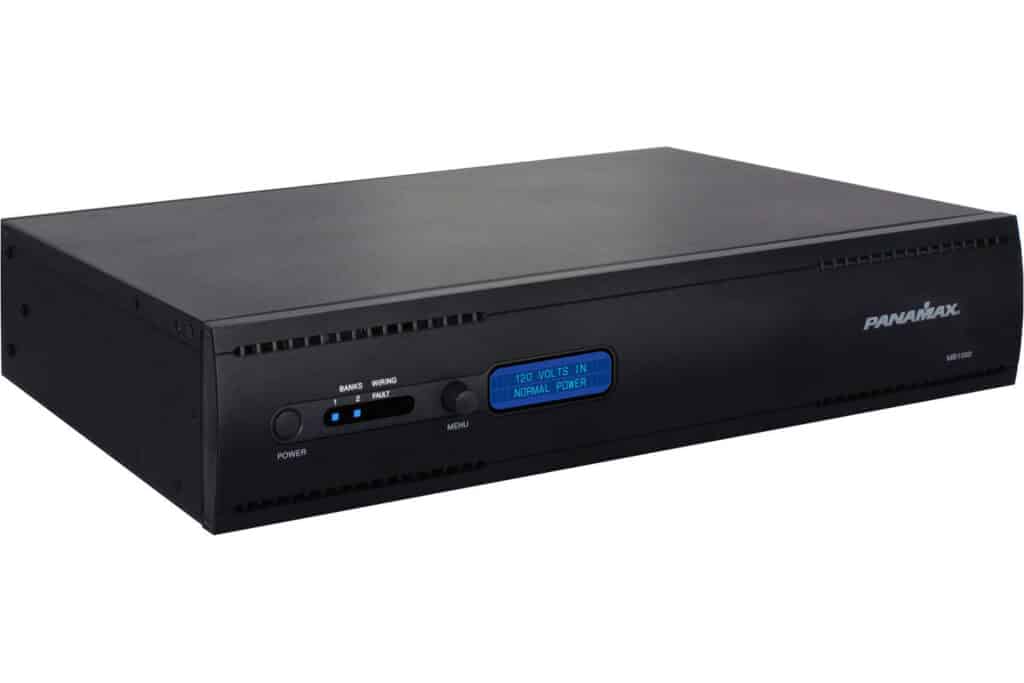
We highly recommend installing UPS units professionally, no matter which product you buy. Although some UPS units require electrical hardwiring, some products have a plug-and-go structure. To prevent the risk of an improper UPS setup, always hire high-voltage electricians to install or at least assess if you have a proper UPS unit installation.
Home UPS Unit Brand Recommendations: Panamax & SurgeX
We recommend buying from Panamax or SurgeX for the best possible home surge protection and power management products for home UPS units.
One of the best ways to protect smart devices from inconsistent power flow and prolong their lifespans is with Panamax’s UPS units. The power that enters your home goes through their UPS devices and distributes a consistent power flow to the electronics and devices connected to it. Instead of your smart devices getting hit by power fluctuations, they receive an even power flow.
SurgeX is another great home UPS option for power surge protection and is recommended by the Home Technology Association (HTA). We suggest putting a SurgeX device in the equipment rack to ensure all network equipment is connected to the battery backup system — so if the power goes out, your internet is still connected.
SurgeX offers the following surge protection features for smart homes:
- battery backup with surge protection included
- easy remote power management — including technicians who can access for troubleshooting and reducing service calls
- wall-mount installations for smart home media like smart TVs and projectors
- branch circuits available to guarantee whole-room surge protection
Panamax and SurgeX offer fully programmable home UPS units compatible with smart homes for easy power management and surge protection.
Low-Voltage Surge Protection Devices (SPDs)
Many home surge protection devices (SPDs) are available for smart homes. So, how do you know which one is best? We always recommend using low-voltage SPDs for less voltage usage.
Low-voltage SPDs use a lower voltage than the standard 120 volts used in most homes for lower electricity use. They’re ideal for smaller smart kitchen and smart bathroom appliances, smart home office devices, and smart living room media like smart TVs and projectors. Low-voltage SPDs also pair perfectly with low-voltage smart lights and low-voltage home pre-wiring for an optimized energy-use system.
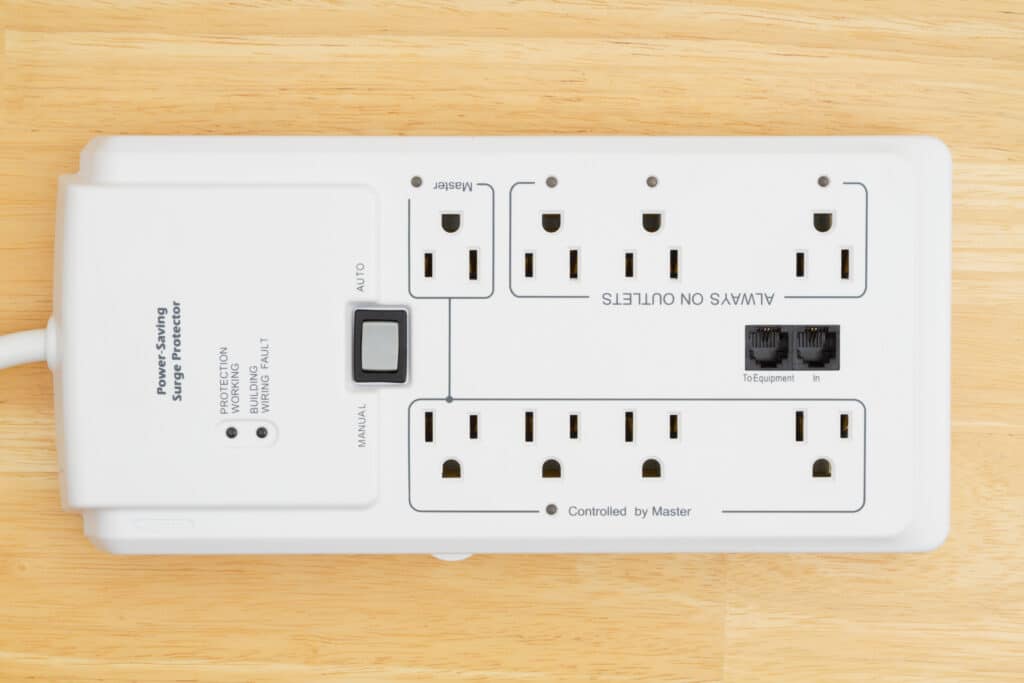
At AIS, our custom system integrators specialize in low-voltage home automation, including low-voltage lighting installation and low-voltage prewiring for home audio and security system installation. Ask us about turning your smart home into a low-voltage system to lower your electricity use and risk of internal power surges.
Low Voltage SPD Brand Recommendation: Wattbox
Our brand recommendation for low-voltage SPDs is Wattbox. They offer products with monitoring abilities and remote device access for power cycling when electronics aren’t working. Most WattBox products are surge protected and connect to home automation systems that allow integrators to remotely power cycle your devices without service calls.
Some smart home features Wattbox offers with their SPDs include:
- built-in 15A circuit breaker to prevent electrical overloads and damage
- automatic shutoff if the power strip is overloading
- slim design and keyhole mounting template for even installation and positioning
SPDs are like a power strip that you plug devices into so integrators can label them in their systems. This lets integrators know which smart device is plugged into each plug to power cycle the devices one plug at a time instead of having to power cycle the entire power strip.
Protect Your Smart Home from Surge Damage with Smart Power Management
At AIS, we always recommend power management and surge protection for smart homes to our clients. If you don’t know where to start, we can suggest the surge protection equipment needed to protect each smart device, equipment, and custom automated system in your home.
Every smart home is unique and requires different power management and surge protection solutions – and we don’t expect you to be an electrical or home automation expert.
Contact us to learn your smart home’s surge protection requirements with product recommendations, or integrate your home automation system with power management today!

